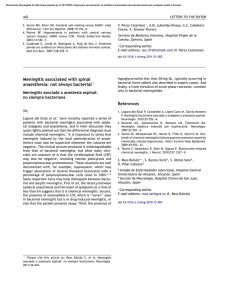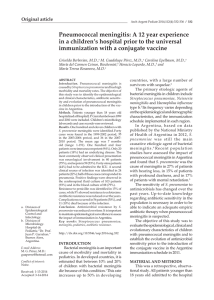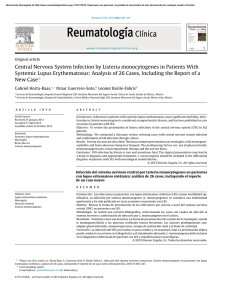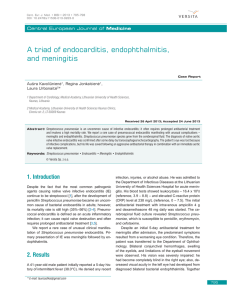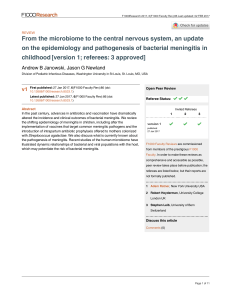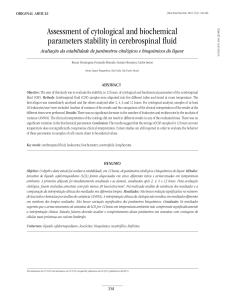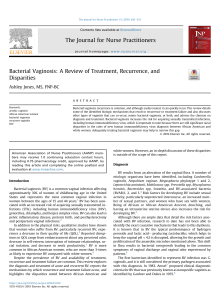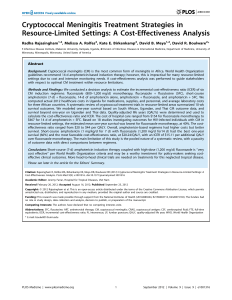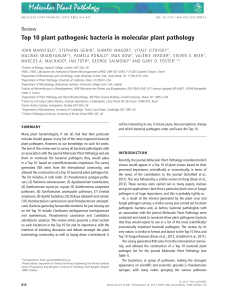Meningitis associated with spinal anaesthesia: not always bacterial
Anuncio
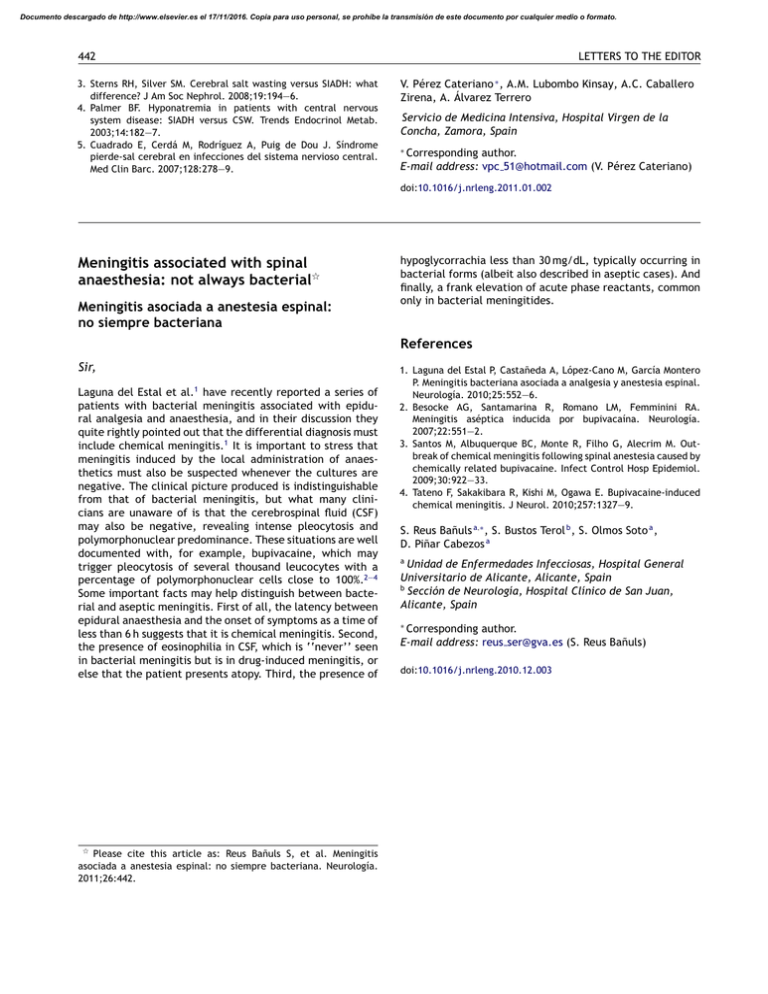
Documento descargado de http://www.elsevier.es el 17/11/2016. Copia para uso personal, se prohíbe la transmisión de este documento por cualquier medio o formato. 442 LETTERS TO THE EDITOR 3. Sterns RH, Silver SM. Cerebral salt wasting versus SIADH: what difference? J Am Soc Nephrol. 2008;19:194—6. 4. Palmer BF. Hyponatremia in patients with central nervous system disease: SIADH versus CSW. Trends Endocrinol Metab. 2003;14:182—7. 5. Cuadrado E, Cerdá M, Rodríguez A, Puig de Dou J. Síndrome pierde-sal cerebral en infecciones del sistema nervioso central. Med Clin Barc. 2007;128:278—9. V. Pérez Cateriano ∗ , A.M. Lubombo Kinsay, A.C. Caballero Zirena, A. Álvarez Terrero Servicio de Medicina Intensiva, Hospital Virgen de la Concha, Zamora, Spain Corresponding author. E-mail address: vpc [email protected] (V. Pérez Cateriano) ∗ doi:10.1016/j.nrleng.2011.01.002 Meningitis associated with spinal anaesthesia: not always bacterial夽 Meningitis asociada a anestesia espinal: no siempre bacteriana hypoglycorrachia less than 30 mg/dL, typically occurring in bacterial forms (albeit also described in aseptic cases). And finally, a frank elevation of acute phase reactants, common only in bacterial meningitides. References Sir, 1 Laguna del Estal et al. have recently reported a series of patients with bacterial meningitis associated with epidural analgesia and anaesthesia, and in their discussion they quite rightly pointed out that the differential diagnosis must include chemical meningitis.1 It is important to stress that meningitis induced by the local administration of anaesthetics must also be suspected whenever the cultures are negative. The clinical picture produced is indistinguishable from that of bacterial meningitis, but what many clinicians are unaware of is that the cerebrospinal fluid (CSF) may also be negative, revealing intense pleocytosis and polymorphonuclear predominance. These situations are well documented with, for example, bupivacaine, which may trigger pleocytosis of several thousand leucocytes with a percentage of polymorphonuclear cells close to 100%.2—4 Some important facts may help distinguish between bacterial and aseptic meningitis. First of all, the latency between epidural anaesthesia and the onset of symptoms as a time of less than 6 h suggests that it is chemical meningitis. Second, the presence of eosinophilia in CSF, which is ‘‘never’’ seen in bacterial meningitis but is in drug-induced meningitis, or else that the patient presents atopy. Third, the presence of 夽 Please cite this article as: Reus Bañuls S, et al. Meningitis asociada a anestesia espinal: no siempre bacteriana. Neurología. 2011;26:442. 1. Laguna del Estal P, Castañeda A, López-Cano M, García Montero P. Meningitis bacteriana asociada a analgesia y anestesia espinal. Neurología. 2010;25:552—6. 2. Besocke AG, Santamarina R, Romano LM, Femminini RA. Meningitis aséptica inducida por bupivacaína. Neurología. 2007;22:551—2. 3. Santos M, Albuquerque BC, Monte R, Filho G, Alecrim M. Outbreak of chemical meningitis following spinal anestesia caused by chemically related bupivacaine. Infect Control Hosp Epidemiol. 2009;30:922—33. 4. Tateno F, Sakakibara R, Kishi M, Ogawa E. Bupivacaine-induced chemical meningitis. J Neurol. 2010;257:1327—9. S. Reus Bañuls a,∗ , S. Bustos Terol b , S. Olmos Soto a , D. Piñar Cabezos a a Unidad de Enfermedades Infecciosas, Hospital General Universitario de Alicante, Alicante, Spain b Sección de Neurología, Hospital Clínico de San Juan, Alicante, Spain Corresponding author. E-mail address: reus [email protected] (S. Reus Bañuls) ∗ doi:10.1016/j.nrleng.2010.12.003 Documento descargado de http://www.elsevier.es el 17/11/2016. Copia para uso personal, se prohíbe la transmisión de este documento por cualquier medio o formato. LETTERS TO THE EDITOR Reply to Meningitis secondary to spinal anaesthesia: not always bacterial meningitis夽 Respuesta a meningitis asociada a anestesia espinal: no siempre bacteriana Sir, We agree with Reus Bañuls et al. about the importance of defining, when evaluating patients with acute meningeal syndrome and negative results in Gram-staining and cerebrospinal fluid (CSF), whether the meningitis is bacterial (MB) or aseptic (MA).1 This differentiation allows treatment to be adapted (need for antibiotic therapy), admission to hospital prescribed or its duration adjusted, and accurate prognostic information to be provided to the patient, etc. The distinction between these two large groups of acute meningitis cases arises in those acquired in the community, where MB would basically tend to be differentiated from viral infections,2 but also from other, less frequent aetiologies such as drugs (trimetroprim-sulphamethoxazole, non-steroidal anti-inflammatory drugs, immunoglobulins, etc.), intracranial tumours that may be a cause of chemical meningitis (dermoid cysts, craniopharyngioma, infarction of a pituitary adenoma) or systemic diseases occasionally coursing with meningeal involvement (lupus erythematosus, sarcoidosis, Behçet’s disease, etc.). It is no less important to distinguish both types of meningitis in an in-hospital setting as numerous medical procedures can lead to complications with either MB or chemical MA: neurosurgery,3 intrathecal administration of medication4 and spinal anaesthesia and analgesia.5 In connection with this last technique, the subject of the report mentioned, it should be recalled that MA secondary to spinal anaesthesia was not so infrequent during the first half of the 20th century, with an estimated incidence of 0.26%.6 Nonetheless, the improvement in material sterilization procedures and aseptic techniques, the use of disposable medical material and the administration of drugs with less allergy-producing effects have meant that chemical meningitis as a complication of spinal anaesthesia is currently exceptional and reflected in case reports when diagnosed. Yet, however frequent and relevant it may be, the problem of differentiating MB from chemical MA secondary to medical procedures has not been resolved when the basic microbiological studies are negative. It is true that the presenting clinical symptoms and CSF analysis (cell count and formula, proteins and glucose) do not enable this distinction to be drawn,7,8 although a short latency prior to the appearance of symptoms and the observation of eosinophils in the CSF (present in only 22% of the cases reported by San- 夽 Please cite this article as: Laguna del Estal P. Respuesta a meningitis asociada a anestesia espinal: no siempre bacteriana. Neurología. 2011;26:442—3. 443 tos et al.5 ) suggest a chemical origin in cases secondary to the use of drugs delivered through the spine. It might be diagnostically more useful to determine a series of different inflammation/infection markers, which are considerably elevated in severe bacterial infections such as MB, but not in chemical meningitis: reactive C protein in serum,8 procalcitonin in serum8 and lactic acid in the CSF.9 However, differentiating them quickly and for sure will not be possible until the techniques for detecting bacterial genoma in the CSF through polymerase chain reaction10 are standardized. References 1. Connolly KJ, Hammer SM. The acute aseptic meningitis syndrome. Infect Dis Clin N Am. 1990;4:599—622. 2. Lee BE, Davies HD. Aseptic meningitis. Curr Opin Infect Dis. 2007;20:272—7. 3. Forgacs P, Geyer CA, Freidberg SR. Characterization of chemical meningitis after neurological surgery. Clin Infect Dis. 2001;32:179—85. 4. Groves MD, Glantz MJ, Chamberlain MC, Baumgartner BE, Conrad CA, Hsu S, et al. A multicenter phase II trial of intrathecal topotecan in patients with meningeal malignancies. Neuro Oncol. 2008;10:208—15. 5. Santos MC, De Albuquerque BC, Monte RL, Filho GG, Alecrim MG. Outbreak of chemical meningitis following spinal anesthesia caused by chemically related bupivacaine. Infect Control Hops Epidemiol. 2009;30:922—4. 6. Thorsen G. Neurological complications after spinal anesthesia and results from 2493 follow-up cases. Acta Chir Scand. 1947;95 Suppl. 121:79—94. 7. Schade RP, Schinkel J, Roelandse FW, Geskus RB, Visser LG, Van Dijk JM, et al. Lack of value of routine analysis of cerebrospinal fluid for prediction and diagnosis of external drainage-related bacterial meningitis. J Neurosurg. 2006;104:101—8. 8. Ray P, Badarou-Acossi G, Viallon A, Boutoille D, Arthaud M, Trystam D, et al. Accuracy of the cerebrospinal fluid results to differentiate bacterial from non bacterial meningitis, in case of negative Gram-stained smear. Am J Emerg Med. 2007;25:179—84. 9. Leib SL, Boscacci R, Gratzl O, Zimmerli W. Predictive value of cerebrospinal fluid (CSF) lactate level versus CSF/blood glucose ratio for the diagnosis of bacterial meningitis following neurosurgery. Clin Infect Dis. 1999;29:69—74. 10. Schuurman T, De Boer RF, Kooistra-Smid AM, Van Zwet AA. Prospective study of use of PCR amplification and sequencing of 16S ribosomal DNA from cerebrospinal fluid for diagnosis of bacterial meningitis in a clinical setting. J Clin Microbiol. 2004;42:734—40. P. Laguna del Estal Servicio de Medicina Interna, Hospital Universitario Puerta de Hierro-Majadahonda, Majadahonda, Madrid, Spain E-mail address: [email protected] doi:10.1016/j.nrleng.2011.01.004
